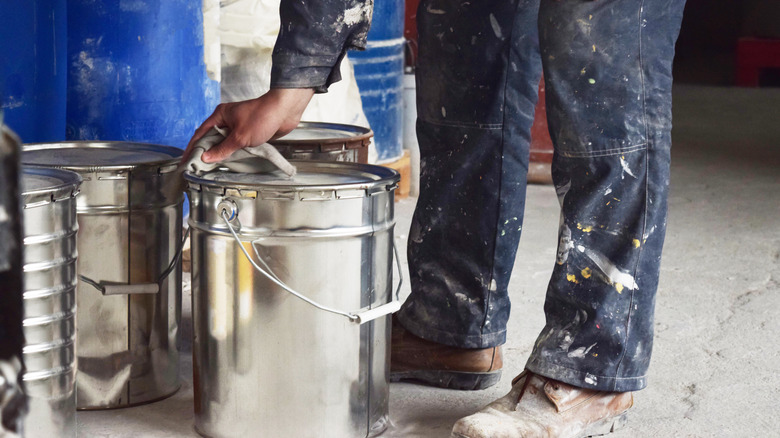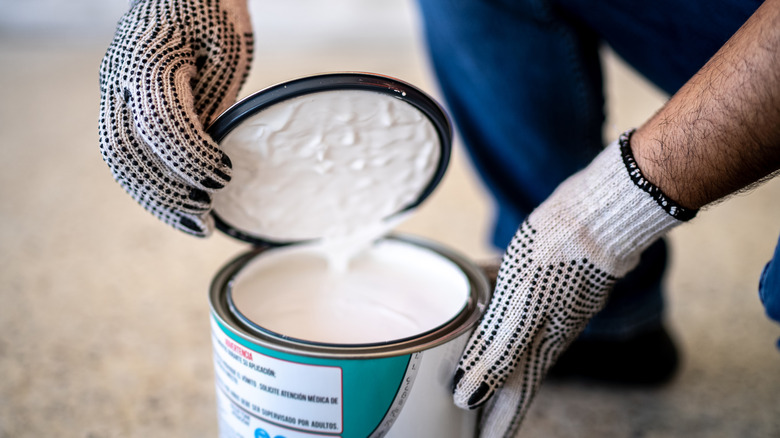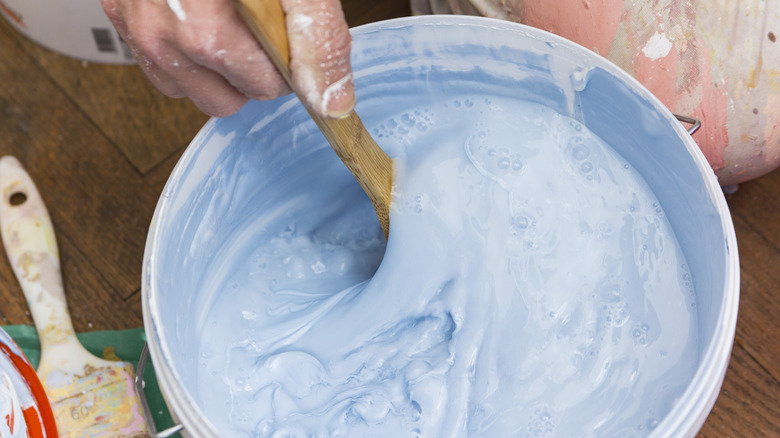Can You Revive Frozen Paint That Sat In Your Garage Overnight?
The garage is often home to many remnants of our past or upcoming home improvement projects: tools, hardware, spare parts, and even paint. But it can be hard to remember that leftover paint needs to be stored in a room-temperature setting at all times, especially if living in a region prone to significant spikes in temperatures year-round. To be specific, paint behaves best when kept in a space measuring between 60 and 80 degrees Fahrenheit. Temperatures beyond this range may cause your leftover paint to shift in texture, rendering it unusable if left in unsuitable conditions for indefinite amounts of time. Frozen paint can be thawed and reused on some occasions, but in more extreme cases, it's best to toss the entire can and buy more, especially if there's a noticeable change in consistency.
Fortunately for homeowners, many formulas of paint can endure at least one freeze and thawing before their consistency is permanently altered. Regardless, paint of all kinds should be handled carefully, whether you're using, discarding, or storing it. Using expired paint or paint that wasn't left to properly thaw after freezing will not only result in a shoddy-looking paint job but may also act as a health hazard for you and the other residents of your home.
How to tell if paint is revivable
Determine whether a can of paint can be saved after freezing by examining its appearance. Paint solidifies as it freezes, just like any other liquid exposed to freezing temperatures. The formula may begin to look stringy or resemble cottage cheese once it starts to thaw, in which case the paint is likely unable to be revived. Paint needs to revert to its original consistency in order to be used as normal. This is less likely to occur with water-based formulas, as water freezes at higher temperatures compared to oil, making the substance more vulnerable to permanent ruin. Oil-based paint, on the other hand, is much more resistant to freezing temperatures.
Paint can also emit a strong odor when it's spoiled beyond repair, one that is noticeably different from the smell of a fresh can that has been properly sealed. If a rancid aroma emerges from your paint that's reminiscent of rotten eggs, the can is almost certainly past its predetermined shelf life or has suffered an air leak, which caused the formula to spoil at a quicker rate than originally intended.
If your formula of paint looks and smells usable, test a sample on an unwanted wooden scrap before applying it to a valuable surface. There may be inconsistencies within the paint invisible to the naked eye.
How to revive frozen paint
When restoring frozen paint, begin by placing the containers in a lukewarm room and giving them ample time to thaw. Don't attempt to speed up the thawing process, as extreme fluctuations in temperature may lead to your paint spoiling. After it has thawed, begin stirring the formula with a paint stirrer, looking for clumps or any other inconsistencies throughout the substance. You can also take the can to a paint store to be professionally shaken. Finally, examine the paint. If the substance looks and smells like your average formula of paint, it should be safe to use for future projects. However, if the paint looks or smells abnormal, it's best to discard it and get some new paint for future jobs instead.
Prevent your next cans of paint from needing to be revived in the first place by ensuring they're properly stored and sealed. Again, the ideal temperature range for storing paint is 60 to 80 degrees Fahrenheit. Settings where the temperature can be controlled are preferred over settings where the temperature can randomly fluctuate, like inside garages and sheds. Placing paint in the correct environment should be enough when saving paint that's never been opened. But if you've already opened the can of paint you want to preserve, add a layer of plastic before hammering the lid back onto the can securely.


